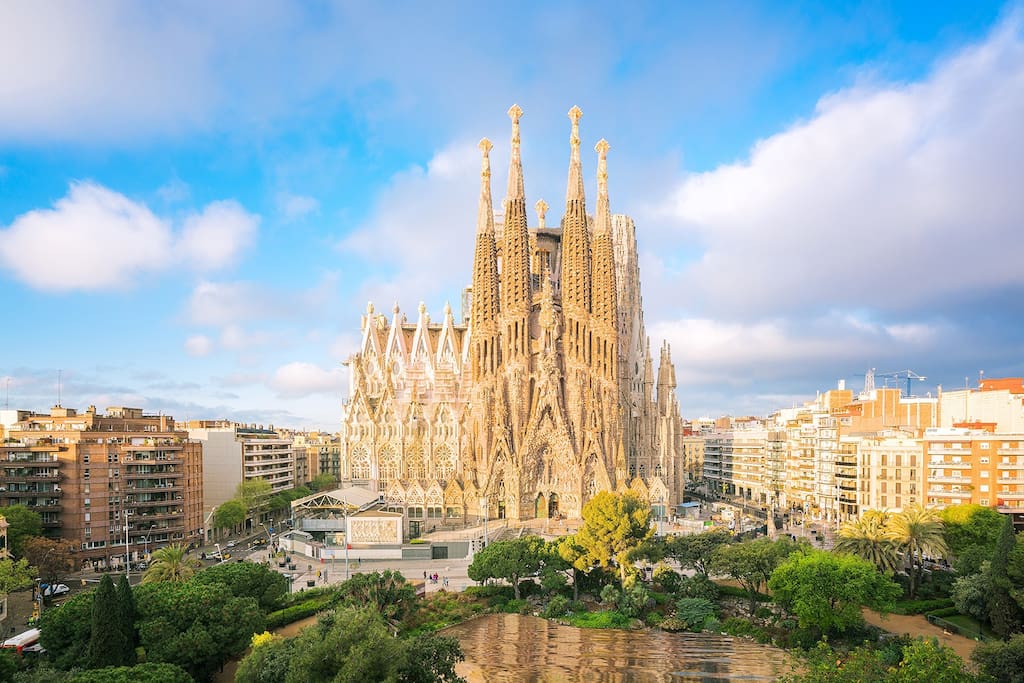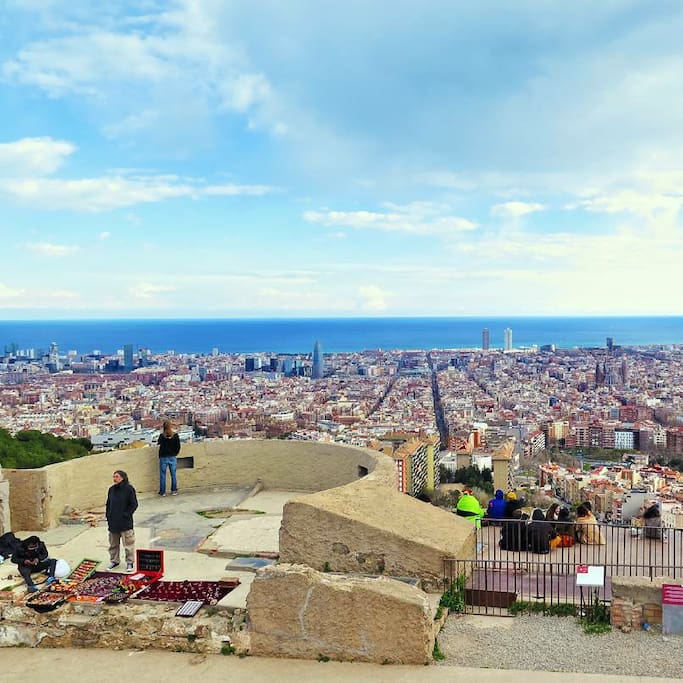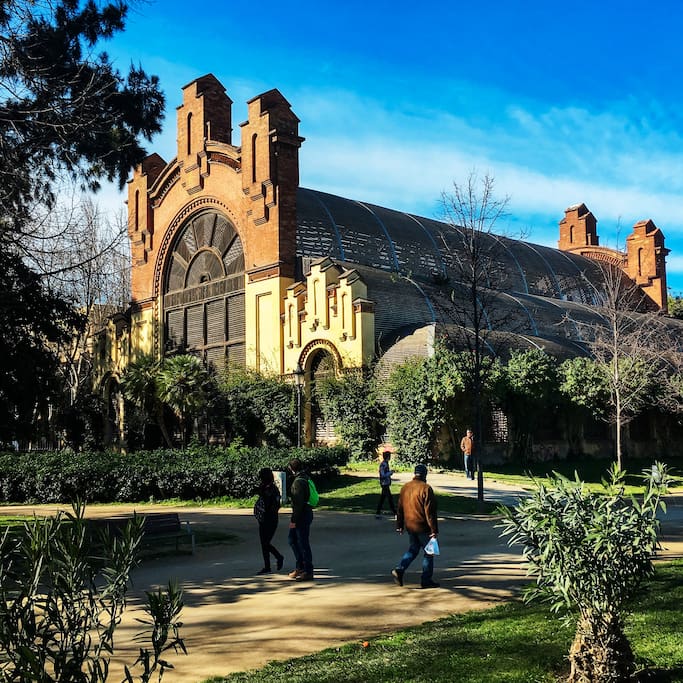Sightseeing
Sagrada Família is a large Roman Catholic church in Barcelona, designed by Spanish architect Antoni Gaudí (1852–1926). Although incomplete, the church is a UNESCO World Heritage Site, and in November 2010 Pope Benedict XVI consecrated and proclaimed it a minor basilica, as distinct from a cathedral, which must be the seat of a bishop.
Construction of Sagrada Família commenced in 1882 and Gaudí became involved in 1883, taking over the project and transforming it with his architectural and engineering style, combining Gothic and curvilinear Art Nouveau forms. Gaudí devoted his last years to the project, and at the time of his death at age 73 in 1926, less than a quarter of the project was complete.
Sagrada Família's construction progressed slowly, as it relied on private donations and was interrupted by the Spanish Civil War, only to resume intermittent progress in the 1950s. Construction passed the midpoint in 2010 with some of the project's greatest challenges remaining and an anticipated completion date of 2026, the centenary of Gaudí's death.
The basílica has a long history of dividing the citizens of Barcelona: over the initial possibility it might compete with Barcelona's cathedral, over Gaudí's design itself, over the possibility that work after Gaudí's death disregarded his design, and the 2007 proposal to build an underground tunnel of Spain's high-speed rail link to France which could disturb its stability. Describing Sagrada Família, art critic Rainer Zerbst said, "It is probably impossible to find a church building anything like it in the entire history of art" and Paul Goldberger called it, "The most extraordinary personal interpretation of Gothic architecture since the Middle Ages.
3229 Einheimische empfehlen
La Sagrada Cerveseria
16 Plaça Sagrada FamíliaSagrada Família is a large Roman Catholic church in Barcelona, designed by Spanish architect Antoni Gaudí (1852–1926). Although incomplete, the church is a UNESCO World Heritage Site, and in November 2010 Pope Benedict XVI consecrated and proclaimed it a minor basilica, as distinct from a cathedral, which must be the seat of a bishop.
Construction of Sagrada Família commenced in 1882 and Gaudí became involved in 1883, taking over the project and transforming it with his architectural and engineering style, combining Gothic and curvilinear Art Nouveau forms. Gaudí devoted his last years to the project, and at the time of his death at age 73 in 1926, less than a quarter of the project was complete.
Sagrada Família's construction progressed slowly, as it relied on private donations and was interrupted by the Spanish Civil War, only to resume intermittent progress in the 1950s. Construction passed the midpoint in 2010 with some of the project's greatest challenges remaining and an anticipated completion date of 2026, the centenary of Gaudí's death.
The basílica has a long history of dividing the citizens of Barcelona: over the initial possibility it might compete with Barcelona's cathedral, over Gaudí's design itself, over the possibility that work after Gaudí's death disregarded his design, and the 2007 proposal to build an underground tunnel of Spain's high-speed rail link to France which could disturb its stability. Describing Sagrada Família, art critic Rainer Zerbst said, "It is probably impossible to find a church building anything like it in the entire history of art" and Paul Goldberger called it, "The most extraordinary personal interpretation of Gothic architecture since the Middle Ages.
Anyone looking to get an incredible bird's-eye view of Barcelona, Catalonia, need look no further than the hilltop ruins of the Bunkers del Carmel. Built as anti-aircraft fortifications in 1938, during the Spanish Civil War, the bunkers atop the hill of Turó de la Rovira were situated so that they could survey the entirety of the city. Large 105 mm cannons were mounted on the concrete and masonry defenses and helped protect Barcelona from further bombing.
After the war, the guns were removed and the bunkers were simply left to crumble. Yet the view from the site was too lovely to stay neglected for long and eventually the old bunkers became known as a beautiful, if a bit remote, place to take in the historic city.
In the 2000s, as the popularity of the site grew, the bunkers received a renovation as officials wanted to make it more appealing to tourists as well as celebrate the ancient Iberian settlement that is also nearby. The formerly secret site now regularly sees visitors, but is secluded enough that it is often still fairly private.
412 Einheimische empfehlen
MUHBA Turó de la Rovira
s/n Carrer de Marià LabèrniaAnyone looking to get an incredible bird's-eye view of Barcelona, Catalonia, need look no further than the hilltop ruins of the Bunkers del Carmel. Built as anti-aircraft fortifications in 1938, during the Spanish Civil War, the bunkers atop the hill of Turó de la Rovira were situated so that they could survey the entirety of the city. Large 105 mm cannons were mounted on the concrete and masonry defenses and helped protect Barcelona from further bombing.
After the war, the guns were removed and the bunkers were simply left to crumble. Yet the view from the site was too lovely to stay neglected for long and eventually the old bunkers became known as a beautiful, if a bit remote, place to take in the historic city.
In the 2000s, as the popularity of the site grew, the bunkers received a renovation as officials wanted to make it more appealing to tourists as well as celebrate the ancient Iberian settlement that is also nearby. The formerly secret site now regularly sees visitors, but is secluded enough that it is often still fairly private.
Parks & Nature
The Park Güell (Catalan: Parc Güell [ˈparɡ ˈɡweʎ]) is a public park system composed of gardens and architectonic elements located on Carmel Hill, in Barcelona, Catalonia (Spain). Carmel Hill belongs to the mountain range of Collserola – the Parc del Carmel is located on the northern face. Park Güell is located in La Salut, a neighborhood in the Gràcia district of Barcelona. With urbanization in mind, Eusebi Güell assigned the design of the park to Antoni Gaudí, a renowned architect and the face of Catalan modernism. The park was built between 1900 and 1914 and was officially opened as a public park in 1926. In 1984, UNESCO declared the park a World Heritage Site under “Works of Antoni Gaudí”
648 Einheimische empfehlen
Park Güell
The Park Güell (Catalan: Parc Güell [ˈparɡ ˈɡweʎ]) is a public park system composed of gardens and architectonic elements located on Carmel Hill, in Barcelona, Catalonia (Spain). Carmel Hill belongs to the mountain range of Collserola – the Parc del Carmel is located on the northern face. Park Güell is located in La Salut, a neighborhood in the Gràcia district of Barcelona. With urbanization in mind, Eusebi Güell assigned the design of the park to Antoni Gaudí, a renowned architect and the face of Catalan modernism. The park was built between 1900 and 1914 and was officially opened as a public park in 1926. In 1984, UNESCO declared the park a World Heritage Site under “Works of Antoni Gaudí”
The Parc de la Ciutadella is a park on the northeastern edge of Ciutat Vella, Barcelona, Catalonia. For decades following its creation in the mid-19th century, this park was the city's only green space. The 70 acres (280,000 m2) grounds include the city zoo (once home to the albino gorilla Snowflake, who died in 2004), the Parliament of Catalonia, a small lake, museums, and a large fountain designed by Josep Fontserè (with possible contributions by the young Antoni Gaudí).
2289 Einheimische empfehlen
Ciutadella Park
21 Passeig de PicassoThe Parc de la Ciutadella is a park on the northeastern edge of Ciutat Vella, Barcelona, Catalonia. For decades following its creation in the mid-19th century, this park was the city's only green space. The 70 acres (280,000 m2) grounds include the city zoo (once home to the albino gorilla Snowflake, who died in 2004), the Parliament of Catalonia, a small lake, museums, and a large fountain designed by Josep Fontserè (with possible contributions by the young Antoni Gaudí).
Food Scene
This mall has many different restaurants with a lovely market where you can eat below
391 Einheimische empfehlen
Goofretti Glories
208 Avinguda DiagonalThis mall has many different restaurants with a lovely market where you can eat below
Drinks & Nightlife
Great road that has many bars to eat and drink and leads to down to the beach
198 Einheimische empfehlen
Rambla del Poblenou
Rambla del PoblenouGreat road that has many bars to eat and drink and leads to down to the beach
Port Olímpic
Nice area for clubbing and excellent restaurants and beach
Shopping
The origins of Mercat del Clot go back to the 19th century, when the neighbourhood belonged to the separate town of Sant Martí de Provençals and had an open-air market
to which local farmers brought their produce.
By the end of the 19th century, the growth in the local population meant that a permanent covered market was necessary and in 1889, the fine structure built by Pere Falqués i Urpí opened to the public.
Made out of brick and supported on an iron frame, this striking building is pre-Modernista and almost like a church, the inside, where the stalls are located, is divided into three sections.
Over the years Clot Market has undergone a number of restorations, principally in 1964, 1969 and the most recent and important one in 1995.
Today, the Mercat del Clot is one of the most emblematic Barcelona markets and a focus for the local community as it offers plenty of activities, such as cooking courses and occasional exhibitions, as well as participating actively in festivals and celebrations.
As well as the typical offer of meat, poultry, fish, fruit and vegetables and frozen foods, Clot Market has a bar and stalls selling non-food items outside the main building.
32 Einheimische empfehlen
Mercat del Clot
26 Plaça del MercatThe origins of Mercat del Clot go back to the 19th century, when the neighbourhood belonged to the separate town of Sant Martí de Provençals and had an open-air market
to which local farmers brought their produce.
By the end of the 19th century, the growth in the local population meant that a permanent covered market was necessary and in 1889, the fine structure built by Pere Falqués i Urpí opened to the public.
Made out of brick and supported on an iron frame, this striking building is pre-Modernista and almost like a church, the inside, where the stalls are located, is divided into three sections.
Over the years Clot Market has undergone a number of restorations, principally in 1964, 1969 and the most recent and important one in 1995.
Today, the Mercat del Clot is one of the most emblematic Barcelona markets and a focus for the local community as it offers plenty of activities, such as cooking courses and occasional exhibitions, as well as participating actively in festivals and celebrations.
As well as the typical offer of meat, poultry, fish, fruit and vegetables and frozen foods, Clot Market has a bar and stalls selling non-food items outside the main building.
Everything Else
La Rambla is a street in central Barcelona, popular with tourists and locals alike. A tree-lined pedestrian mall, it stretches for 1.2 kilometres (0.75 mi) connecting Plaça de Catalunya in the centre with the Christopher Columbus Monument at Port Vell. La Rambla forms the boundary between the quarters of Barri Gòtic, to the east, and El Raval, to the west.[1][2]
La Rambla can be crowded, especially during the height of the tourist season. Its popularity with tourists has affected the character of the street, with a move to pavement cafes and souvenir kiosks. It has also suffered from the attention of pickpockets and, especially towards its southern end, sex workers.[2]
The Spanish poet Federico García Lorca once said that La Rambla was "the only street in the world which I wish would never end
63 Einheimische empfehlen
Las Ramblas Bacardi Apartments
1 Passatge de BacardíLa Rambla is a street in central Barcelona, popular with tourists and locals alike. A tree-lined pedestrian mall, it stretches for 1.2 kilometres (0.75 mi) connecting Plaça de Catalunya in the centre with the Christopher Columbus Monument at Port Vell. La Rambla forms the boundary between the quarters of Barri Gòtic, to the east, and El Raval, to the west.[1][2]
La Rambla can be crowded, especially during the height of the tourist season. Its popularity with tourists has affected the character of the street, with a move to pavement cafes and souvenir kiosks. It has also suffered from the attention of pickpockets and, especially towards its southern end, sex workers.[2]
The Spanish poet Federico García Lorca once said that La Rambla was "the only street in the world which I wish would never end
Essentials
Mercadona
373 Gran Via de les Corts CatalanesSupermarket. Can get pretty much everything you need
A two-floor hypermarket at the centre of a mall style commercial centre in Gloriés. Along with food, the hypermarket also offers a wide range of electrical appliances, DVDs, garden furniture, home ware and a pharmacy.
58 Einheimische empfehlen
Carrefour
208 Carrer de la LlacunaA two-floor hypermarket at the centre of a mall style commercial centre in Gloriés. Along with food, the hypermarket also offers a wide range of electrical appliances, DVDs, garden furniture, home ware and a pharmacy.



